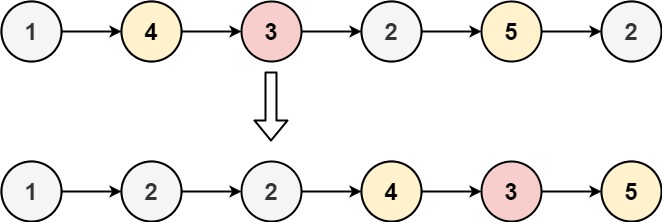[LeetCode April Challange] Day 14 - Partition List
Given the head of a linked list and a value x, partition it such that all nodes less than x come before nodes greater than or equal to x.
You should preserve the original relative order of the nodes in each of the two partitions.
Example 1:

Input: head = [1,4,3,2,5,2], x = 3
Output: [1,2,2,4,3,5]
Example 2:
Input: head = [2,1], x = 2
Output: [1,2]
Constraints:
- The number of nodes in the list is in the range [0, 200].
- -100 <= Node.val <= 100
- -200 <= x <= 200
Solution
/**
* Definition for singly-linked list.
* struct ListNode {
* int val;
* ListNode *next;
* ListNode() : val(0), next(nullptr) {}
* ListNode(int x) : val(x), next(nullptr) {}
* ListNode(int x, ListNode *next) : val(x), next(next) {}
* };
*/
class Solution {
public:
ListNode* partition(ListNode* head, int x) {
ListNode *lt_dummy_head = new ListNode();
ListNode *egt_dummy_head = new ListNode();
ListNode *lt = lt_dummy_head;
ListNode *egt = egt_dummy_head;
for (ListNode *curr=head; curr; curr=curr->next) {
if (curr->val < x) {
lt->next = curr;
lt = lt->next;
} else {
egt->next = curr;
egt = egt->next;
}
}
egt->next = nullptr;
lt->next = egt_dummy_head->next;
return lt_dummy_head->next;
}
};
從頭到尾掃一遍,用兩個指標記錄 小於x & 大於等於x 的 node 順序。
掃完後,將 lt 與 egt 串起來,egt 下一個設為 nullptr,完工。